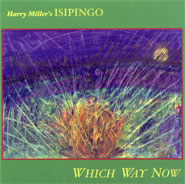Harry
Miller's Isipingo
Which
Way Now
(Cuneiform)
It's
incredibly easy for me to recall the first time I happened to listen to
Harry Miller: the stylus in my turntable had just descended on the grooves
of King Crimson's new LP, Islands, when the beautiful sound of a double
bass, played arco, started giving shape to the main theme of Formentera
Lady; after what to me sounded like a minor eternity (in reality it was
only a few seconds) Mel Collins's flute and Keith Tippett's piano joined
the bass. Later, it was the piano that together with Robert Fripp's Mellotron
and Mark Charig's cornet took the track of the same name - and the whole
album - to its majestic conclusion.
Harry
Miller's double bass was not the first discovery for which one had to be
grateful to King Crimson and Robert Fripp. Keith Tippett's piano had been
the unanticipated guest on In The Wake Of Poseidon (1970), and the piano's
explosive contribution - also on an atypical single such as Cat Food -
had surprised quite a few listeners. The same year, Tippett had again appeared
on Lizard, this time alongside Mark Charig's cornet and Nick Evans's trombone:
for many this was their first real exposure to "new English jazz".
(Likewise, the first time when many heard Mongezi Feza's explosive trumpet
was on Rock Bottom, Robert Wyatt's acclaimed masterpiece.)
(It's
not only people like Fripp who are nowadays absent. Just as decisive is
the other half of the equation: an audience where people are ready to be
intrigued by a sound, and also ready to examine an album cover in order
to determine the nature of its source; people who will then remember the
name of the player, and will look for it on other albums. Right. Time to
reach for one's handkerchiefs.)
Had
it been born in the United States (!), today "New English Jazz" would
be better known - and better documented - than it is. But even at that
time, it had been the Continent that had somewhat greeted this music, and
its creators. So the complete liner notes written by Francesco Martinelli
are twice precious: while they are indispensable as a nice introduction
to the "genre", this album and Harry Miller, they are also quite
useful as a starting point for any listener who will decide to continue
the journey.
As
it lately happens in cases like this, the recording of Which Way Now (the
concert took place in 1975) is by Radio Bremen. Good remastering ("tube
remastering") by Canadian firm Sounds Good: Nick Evans's trombone,
Mongezi Feza's trumpet, Mike Osborne's alto sax are very clear, just like
Harry Miller's double bass; Tippett's piano is always within ear's range,
while Louis Moholo's drums, which naturally gravitate towards the cymbals,
suffer less than I had anticipated. Seventy-five minute for four tracks
(the usual "one track per side" from the old times), performances
that take their time, an album that's a document of a rare moment in music
but whose listening is to be suggested on the grounds of its being of a
very high quality. Which, for once, goes hand-in-and with the music being
quite accessible.
The
joyous theme, reminding one of a fanfare, a parade, of Family Affair introduces
us to that dimension so typical of quite a few musicians who came from
South Africa; it's interesting to notice the way Tippett's piano, in its
counterpoint to the theme, starting at about 42", sounds quite similar
to steel drums; excellent solo by Evans, with Moholo on cymbals and Tippett
playing
"staccato"; also nice solos by Feza and Osborne, with Tippett referring
back to the theme and a fluid bass playing by Miller.
Children
At Play is without a doubt the most "dancing", swinging, composition
here; the first solo is by Osborne, the second one by Feza, at times tortuous,
at times lyrical; here Evans plays what to me sounds like his best solo
on this album; Tippett's solo is also excellent, as is Miller's solo, which
follows.
Eli's
Song reminded me of Soft Machine: at first we have a "fanfare",
and drums sounding quite a bit à la Wyatt; then a theme not too distant
from those atmospheres made of foggy gloom that Hugh Hopper composed at
the time of Fourth. The first solo is by Evans, then Feza, then Osborne,
who plays what I think is his best on this album - funny thing, it reminded
me a lot of some alto/saxello climates by Elton Dean; also nice are the
solos by Tippett and Miller.
The
theme to Which Way Now reminded me a lot of the music by Charles Mingus;
also the alto solo by Osborne, which at times is quite reminiscent of Eric
Dolphy, and the assertive double bass by Miller while Evans and Feza solo.
Absolutely unexpected is the development starting at 11'33", when
a still piano with the sustain pedal down, and a double bass played arco,
are followed by a return of the Mingus-like opening theme.
Beppe
Colli
©
Beppe Colli 2006
CloudsandClocks.net | Aug.
27, 2006











